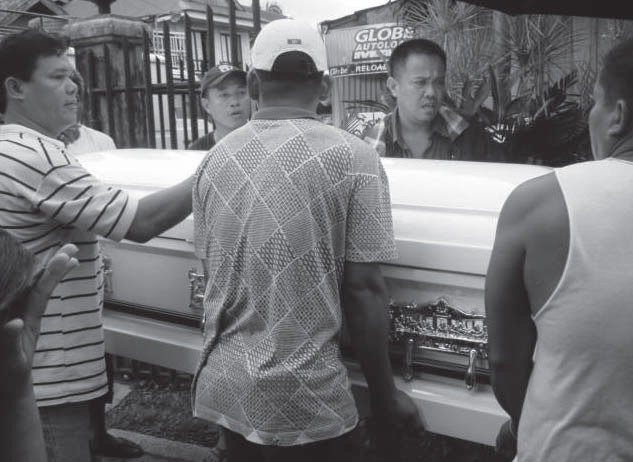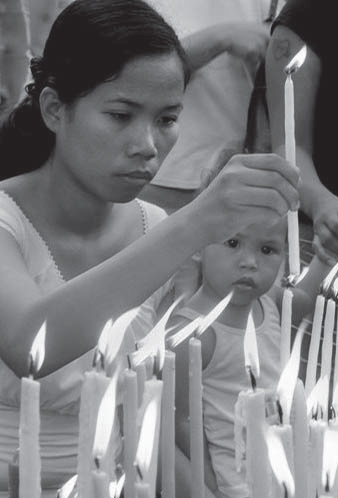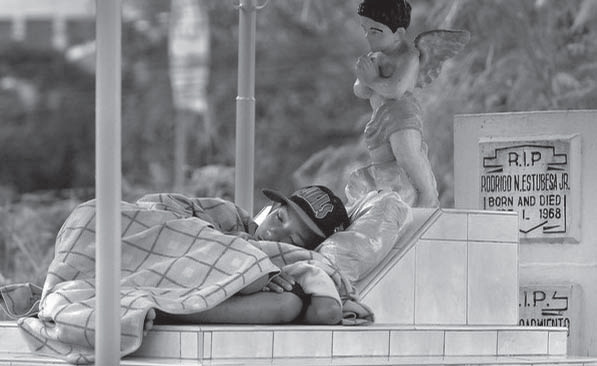
July 16, 2010
CROSSING OVER
“Be respectful of this place, because they were what you are and you will be what they are.”
-sign over Paris cemetery entrance-
I must be the harbinger of death; a bringer of bad news. During my previous twelve trips back home I’ve attended 15 funerals.In 2008 I participated in five funerals! Reader I don’t know but there’s something weird going on here. Seem like whenever I visit the Philippines somebody always get the ‘Heavenly call.’ Like most Americans funerals make me nervous. There’s something that really gets to me knowing that the person you saw alive and ambulatory one week seeing them in that metal box lying so still, silent, stiff as a board and cold the next week send shivers down my spine. Death IS frightening but we all must ‘fly out outta’ here’ sometime.

Death is natural l i k e cornflakes and milk b a c o n and grits in the morning. Science says that nothing ever dies, it only changes. Okaaay… Unlike the United States where death is camouflaged never a topic for ‘polite’ conversation bereavement in the Philippines is accepted as vital to the life-death cycle of change. In the U.S. all commitment to the deceased person ends promptly at the conclusion of the funeral service. Once the dead person is in the ground (or the wall) its’ out-of-sight-out-ofmind quickly forgotten. *Poof* Gone with the wind as though they never existed. In the Philippines, most Catholic, some Protestant Scandinavian countries the dead are remembered centuries after they’ve passed on and their bodies returned to the dust from wench they came.
PHILIPPINE FUNERAL CUSTOMS
Philippine burial customs vary from region to region tribe to tribe. The general overlay for the Christian wake service is pretty much the same world over. After a person dies in the Philippines there’s the traditional wake (lamay or paglalamay) service. The paglalamay last on average from five to seven consecutive nights though longer if the surviving family is waiting for relatives to arrive from distant places to attend the funeral. Unlike the United States guests at Philippines funerary rites get to sing, eat, pray, drink, gamble, play cards, and play musical instruments each night of the wake.

When my Mom + May GOD rest her soul + died we had final visitation in the morning, Rosary Wake with concelebrated Mass that night, with burial next morning bright and early and that was that.
M o s t Filipinos aren’t rich; all guests a r e strongly e n c o u r – aged to leave a donation in the abuloy box to help the surviving family defray funeral exp e n s e s . F o r Catholics Mass is celebrated nightly culminating with the main funeral Mass after the five to seven day wake vigil concludes. The lamay takes place at the funeral home (house of the dead.). Another unique aspect of Filipino funerals is visitors are allowed to ask survivors how the deceased person died, did they suffer, how much for hospital costs, all this to show their genuine sympathy to the family of the deceased. Guests never ask dumb*** questions like they’ve been known to ask at wakes over here (i.e. “How much money did she/he leave behind? I heard she left it all to her 13 cats. His mistress and her lawyer cleaned out all his accounts.”). On the day of the funeral the casket is taken from the funeral or private home, loaded into a funeral car or carried by family members and other participants to the church. Once there proper religious rites take place. After church there’s the solemn funeral march to the cemetery. In my travels back home I only took part in a single funeral march. Reader, that march reminded me of those fancy funerals in my Mother’s ancestral New Orleans home town with their upbeat Jazz (Second Lines) street funerals. I’ve seen second lines but never participated in one. My being in a Philippine funeral march was a novel experience. After our long slow walk from church to tomb, the lengthy march ended with more prayers for the dead, entombment, and back home again for the traditional post-funeral repast.

In Chinese-Filipino funerals the custom of hiring professional mourners are used. Their purpose is to help expedite the dead person’s soul into Heaven by trying to persuade GOD that the soul of the dead person is worthy of Heaven by their incessant weeping and wailing. This elaborate attempt to con the Almighty must put a smile on GOD’S Face. In 2003 there was an award-winning Philippine comedy titled ‘Crying Ladies.’ This film was about three Filipinas who worked part-time as professional mourners for Manila’s affluent Chinese-Filipino community.
MEMORIALIZING THE DEAD
Honoring the dead is pre-historic in origin. Filipino Christians pay formal homage on two days per year: November 1st All Saints Day the day in which many Christian denominations honor the countless trillions of people who have lived honorable lives through the ages. November 2nd is All Souls Day the day to honor souls of individuals in transition between time and eternity (Purgatory Reincarnation? poltergeists?). Special church services are held on both days. It’s on these two feasts that Filipinos customarily spend time at cemeteries doing things for their beloved departed. Grave sites are cleaned; candles lit, prayers prayed, relatives and friends of the deceased place flowers on graves, and have family picnics.
Poor children often scrape up used wax to be remolded and sold later as fresh candles.
Reader that’s it for this week’s Mega Scene’s Philippines Adventures. Web hosting of Filipino death rites and rituals abound over the internet. Space doesn’t permit me to list them all. Funeral customs vary by tribal group, ethnic and religious denomination. To know more about Filipino funeral customs go to: Funeral practices and burial customs in the Philippines…GOD bless you.
“The Pride of dying rich raises the loudest laugh in hell.” -John W. Foster-
(vamaxwell@yahoo.com)



 ShareThis
ShareThis